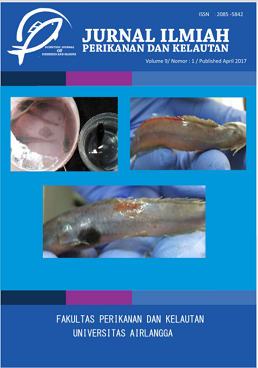Date Log
1. Copyright of the article is transferred to the journal, by the knowledge of the author, whilst the moral right of the publication belongs to the author.
2. The legal formal aspect of journal publication accessibility refers to Creative Commons Atribusi-Non Commercial-Share alike (CC BY-NC-SA), (https://creativecommons.org/licenses/by-nc-sa/4.0/)
3. The articles published in the journal are open access and can be used for non-commercial purposes. Other than the aims mentioned above, the editorial board is not responsible for copyright violation
The manuscript authentic and copyright statement submission can be downloaded ON THIS FORM.
Pigmen Rumput Laut Merah (Acanthophora spicifera) sebagai Alternatif Pewarna Alami pada Produk Sosis Ikan Lele Dumbo (Clarias gariepinus)
[ Seaweed Red Pigment(Acanthophora Spicifera) as Alternative in Producing Natural Dyes of Catfish (Clarias gariepinus) Sausage Produc ]
Corresponding Author(s) : Moch. Amin Alamsjah
Jurnal Ilmiah Perikanan dan Kelautan, Vol. 7 No. 1 (2015): JURNAL ILMIAH PERIKANAN DAN KELAUTAN
Abstract
Abstract
Aquatic resources that have great potential to be developed is a pigment obtained from seaweed. According Winarno (1996), seaweeds are clasified into three classes, namely red algae (Rhodophyceae), brown algae (Phaeophyceae) and green algae (Chlorophyceae). There are three main types of pigment in the seaweed, namely: chlorophyll, carotenoids, and phycocyanin (Lila, 2004). Each type of pigment that provides different benefits to human life. Red seaweed spicifera types Acanthophora be extracted and taken the pigment has a branch color (thallus) are varied, due to the pigment composition consisting of chlorophyll a, chlorophyll d, and fikobiliprotein (R-phycocyanin, allofikosianin and fikoeritrin) (Lee, 2008) . Fikoeritrin is the dominant pigment in red algae, thus giving the appearance of red on the thallus. The use of pigments is very important not only in the food and beverages, but also in medicines, cosmetics and pharmaceutical industrial. It is one of the determinants of consumer acceptance of products offered. Source of pigments used are also used by consumers as one of the indicators in assessing the quality of a product. The use of natural or synthetic dyes in the product will enhance the visual appeal that will increase consumer preference for products offered, therefore, the use of natural dye for industrial cannot be avoided. Based on the description above, this study will extract the pigment from red algae (A.spicifera) with a polar solvent (ethanol, distilled water) which will be used as a dye in catfish sausage with different proportions and determine the color stability during storage at cold temperatures and using the analytical method for determining the wavelength spectrophotometer fikoeritrin extraction results. The aim of the study is getting the appropriate method to produce the red pigment of seaweed A. spicifera, obtain the pigmen concentrate that can be applied to the catfish sausage and determine the stability of the color pigment A. spicifera on application of catfish sausages during storage. The study consisted of two examination to obtain the best dose of A. spicifera pigmen. The first step is to find wavelength of fikoeritrin. The design of the study is completely randomized design RAK with 12 treatmens and 3 replications. The results of the study showed that the red pigmen A. spicifera can be used as a dye in catfish sausage with the best concentration of 0.75%. Concentration and storage time catfish sausage significant effect on the intensity of reddish and yellowish color, but not significantly different to the intensity of brightness and water content. The concentration of pigment A. spicifera different in catfish sausage on organoleptic test gives a significant difference in color, smell and flavor
Keywords
Download Citation
Endnote/Zotero/Mendeley (RIS)BibTeX
- De Garmo E.P., W.G. Sullivan dan J.R. Canada, 1984. Engineering Economy. Seventh Edition. Macmillan Publishing Company. New York.
- Lee RE, 2008. Phycology. Ed ke-4 Cambridge : Cambridge University Press. 547 hal.
- Limantara, L. dan Rahayu, P., 2007. Prospek Kesehatan Pigmen Alami. Prosiding Seminar Nasional Pigmen 2007 MB UKSW.Salatiga.ISBN.979-1098. 16-4.
- Puji Rahayu dan Leenawaty Limantara, 2005. Studi Lapangan Kandungan Khlorofil in Vivo Beberapa Spesies Tumbuhan Hijau di Salatiga dan Sekitarnya. Seminar Nasional MIPA 2005.
- Winarno, FG., 1992. Kimia Pangan dan Gizi. Jakarta. Gramedia Pustaka Utama.
- Winarno, FG., 1996. Teknologi Pengolahan Rumput Laut. Pustaka Sinar Harapan. Jakarta.
References
De Garmo E.P., W.G. Sullivan dan J.R. Canada, 1984. Engineering Economy. Seventh Edition. Macmillan Publishing Company. New York.
Lee RE, 2008. Phycology. Ed ke-4 Cambridge : Cambridge University Press. 547 hal.
Limantara, L. dan Rahayu, P., 2007. Prospek Kesehatan Pigmen Alami. Prosiding Seminar Nasional Pigmen 2007 MB UKSW.Salatiga.ISBN.979-1098. 16-4.
Puji Rahayu dan Leenawaty Limantara, 2005. Studi Lapangan Kandungan Khlorofil in Vivo Beberapa Spesies Tumbuhan Hijau di Salatiga dan Sekitarnya. Seminar Nasional MIPA 2005.
Winarno, FG., 1992. Kimia Pangan dan Gizi. Jakarta. Gramedia Pustaka Utama.
Winarno, FG., 1996. Teknologi Pengolahan Rumput Laut. Pustaka Sinar Harapan. Jakarta.
